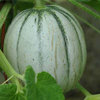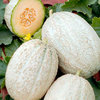Packet Content (approx.): 10
The combination of a casaba and a Persian melon, the Crenshaw is well-known as the sweetest variety of the muskmelon family.
A crenshaw melon is a cross between cantaloupe and casabamelons. How to Select Crenshaw Melon. Select melons with a rich, golden-pink flesh. The skin should be golden and have a waxy texture. The fruit produces a rich melon aroma at the peak of ripeness.
The Crenshaw melon, also spelled Cranshaw, very closely resembles its parent melon, the Casaba. Mostly spherical in shape, it has a somewhat flattened bottom and tapers to a gentle point at the stem-end. The hard rind is yellowish-green, and has a rough corrugated texture void of netting. Its dense yet tender peach-colored flesh is very sweet and slightly spicy. The melon's skin turns golden-yellow at the peak of ripeness and will have slightly waxy feel. Crenshaw melons are quite large, averaging 8 to 10 pounds in weight.
Crenshaw melon this melon takes about 100 days to harvest. They can weigh up to 10 pounds they have a yellow outside skin and a orange flesh inside they are great source for vitamin C
Interested in trying something deliciously different in your garden allotment? Try the Crenshaw Melon is a vigorous fast maturing tolerant of cool conditions and is ideal for growing outdoors in a sunny sheltered position or in an unheated greenhouse or polytunnel.
Sowing: Sow from March to the end of May
Melon seeds are sown from late winter to spring in hotter countries, but in our temperate zone sow indoors from March to the end of May. Sow 1cm (½in) deep directly into 8 to 10cm (3 to 4in) pots using standard free draining potting compost. Keep moist at all time. Seeds will germinate at temperatures above 21°C (68°F). Germination usually takes 6 to 10 days at 24°C (75°F).
Transplant when large enough to handle into 13cm (5in) pots. Grow on in good light at around 15 to 18°C (59 to 64) before planting 75 to 100cm (30 to 39in) apart when all risk of frost has passed. Planting into an unheated glasshouse or polytunnel must not take place until the compost or soil is sufficiently warm (18°C / 64°F ) and the air temperature likewise. Set the plants out firmly but do not compact the soil.
The planting area must be adjacent to suitable support if the melons are to be trained in conventional fashion. When planting, you may wish inserting a 7cm (3in) pipe into the soil so you can water directly to the roots with a watering can.
Top dress with good compost when white roots are seen. If the basal leaves begin to yellow feed with a liquid tomato fertilizer. Feed weekly once the fruits begin to form.
Harvest: July to August.
Judging when melons are ready to harvest is an exact science? don't be told otherwise. Whether it is late in the garden or early in a greenhouse, the plants will tell you when to pick. In the case of the muskmelons (cantaloupe and honeydew), the short stem seems to become backed up with juice, as though the fruit can take no more. It becomes soft to the point that if you give it a slight pinch, the fruit will fall off. Some fruits may actually fall off the vine, so keep a careful eye on each one as it develops.
Many mature cantaloupes are orangey yellow on the outside, beneath all that netting. They are not green. The ones you find in the store are nearly always unripe. They have to be unripe in order to ship them to you. Eating cantaloupe at ideal ripeness is a nuanced dance ? a complex perfection of textures, flavour, and sweetness.
The terminology for picking cantaloupe at full maturity is "full slip", this means that the "belly button" at the top of the melon will be clean of any signs of the vine having been ripped off during harvest. If the belly button has pieces of the vine still attached, even a small piece, this melon will NEVER ripen.
The best test of course is smelling the melon, look for melons where the outside rind is turning from green to yellow a sign of the ripening process and smell it. The cantaloupe should smell sweet and have a fantastic aroma as if you had just taken a knife and cut it open. No smell means it's not ripe, but if the belly button is clean, then it will of course ripen in time.
Also, the belly button should be dry, if you gently push with your thumb the flesh should not come away and no sign of mold should be present. It's okay if the melon is a little soft to touch as long as it's ripe. The same applies to Galia and Musk melons except that the outside rind must always be firm to touch.
Watermelon vines have many more tendrils than cantaloupes, and there is always a tendril very close to, but opposite, the stem to each fruit. When this tendril dries completely and turns from green to brown, the fruit nearest it is ripe. Without fail, this is true.
To speedup the ripening process place the melon in a plastic bag and seal the bag with a twist tie and place on your kitchen counter. This traps the natural ethylene gas cantaloupes produce inside the bag and the melon will ripen in a couple of days. Remove the bag after the cantaloupe has ripened and refrigerate until you're ready to eat it.
Regular feeding is recommended.




















